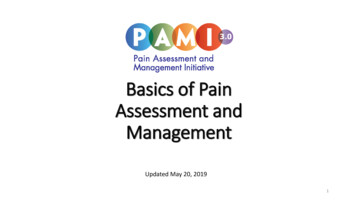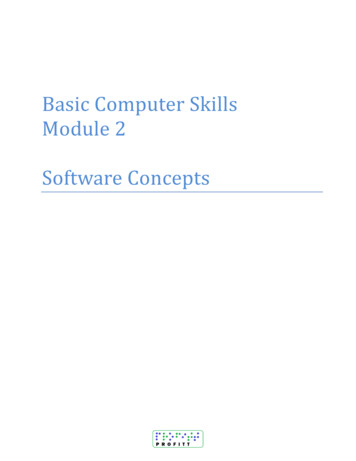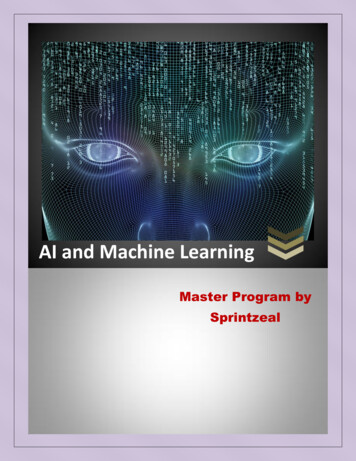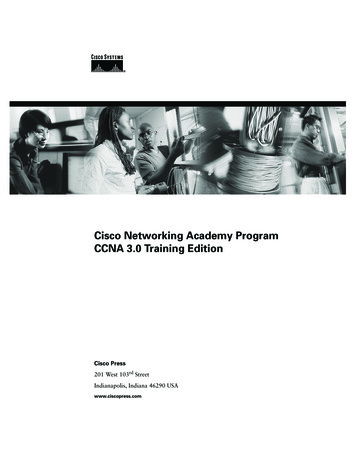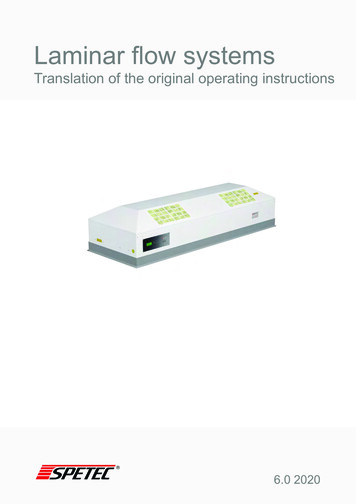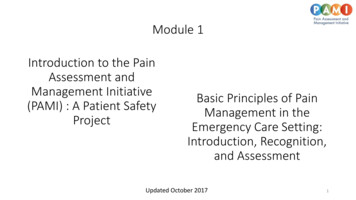
Transcription
Module 1Introduction to the PainAssessment andManagement Initiative(PAMI) : A Patient SafetyProjectBasic Principles of PainManagement in theEmergency Care Setting:Introduction, Recognition,and AssessmentUpdated October 20171
PAMI learning module content will sometimes overlap due to similartopics. The PAMI website offers access to learning module handouts,pain tools, resources, websites, and recent pain news.We welcome your feedback on all PAMI materials and are interestedin how you use them to improve patient safety and clinical care.Please email emresearch@jax.ufl.edu.For more information please visithttp://pami.emergency.med.jax.ufl.edu/Like Us on Facebook at https://goo.gl/4Yh1cB2
Citation for Presentation An electronic version of this document is available on the PAMI rces/pami-moduledownloads/ All PAMI created materials are free access and can be utilized foreducational programs or adapted to institutional needs. Suggested Citation: Basic Principles of Pain Management in the EmergencyCare Setting: Introduction, Recognition, and Assessment. University ofFlorida College of Medicine - Jacksonville, Department of EmergencyMedicine. Pain Assessment and Management Initiative (PAMI): A PatientSafety Project, [date retrieved]. Retrieved fromhttp://pami.emergency.med.jax.ufl.edu/.3
DisclaimerThe PAMI website, learning modules, and resources are for educational and informationalpurposes only. The PAMI website is not intended as a substitute for professional medicaldiagnosis or management by a qualified health care professional. PAMI is not responsible forany legal action taken by a person or organization as a result of information contained in oraccessed through this website, whether such information is provided by PAMI or by a thirdparty. As new research and clinical experience becomes available, patient safety standardswill change. Therefore, it is strongly recommended that physicians, nurses and otherhealthcare professionals remain current on medical literature and national standards of careand structure their treatment accordingly. As a result of ongoing medical advances anddevelopments, information on this site is provided on an “as is” and “as available” basis.Patient care must be individualized. The use of information obtained or downloaded from orthrough this website or module is at the user’s sole discretion and risk.If you use any links that appear in this website or module to other websites, you will leavethe University of Florida’s website. The University of Florida is not responsible for thecontents of any linked site or any link contained in such a linked site. The University of Floridamay provide such links to you only as a convenience and the inclusion of any link does notimply recommendation, approval or endorsement by the University of any third party site. Allsuch links provided on this website are intended solely for the convenience of users of thissite and do not represent any endorsement, advertisement or sponsorship of linked sites orany products or services offered through sites that are not owned by the University.4
Introduction to Pain Assessment and ManagementInitiative (PAMI) : A Patient Safety ProjectThis online module was created to provide general informationon recognition, assessment, diagnosis and treatment of pain inthe context of an interdisciplinary team. Pain terminology,classification, history-taking, physical diagnosis and treatmentconsiderations are included along with case scenarios.While multiple disciplines will find this information useful,physician training programs can utilize content to meet ACGMECore Competencies (patient care, medical knowledge, practicebased learning, interpersonal and communication skills,professionalism and systems-based practice).5
Why is the improvement of pain managementin acute care settings important?Pain is a complex and common complaint that leads to frequent access ofthe US healthcare system. Pain is often under recognized leading to inadequate treatment andnumerous patient safety concerns. These concerns are amplified in special populations such as the young,old, and cognitively impaired; especially in the chaotic EmergencyDepartment (ED) and Emergency Medical Service (EMS) environments.Despite its importance, pain management receives little emphasis in thecurricula of most healthcare professional education programs.6
What is the Purpose of PAMI?The purpose of the Pain Assessment andManagement Initiative (PAMI): A Patient SafetyProject is the advancement of pain recognitionand treatment in acute care settings toimprove patient safety and reduce risk.This project addresses both acute and chronicpain in all ages including high risk populationsand settings such as procedural sedation.7
According to the 2011 IOM Report Relieving Pain in America:A Blueprint for Transforming Prevention, Care, Educationand Research Acute and chronic pain affects large numbers of Americans withapproximately 100 million U.S. adults burdened by chronic painalone. The estimated annual cost of chronic pain is 600 billion, whichexceeds the cost of each of the nation’s priority health conditionsand excludes acute and cancer-related pain. Pain is the most common reason for seeking health care, and as apresenting complaint, accounts for up to 78% of visits to the ED. Additionally, a conservative estimate is that 20 - 25% of EMSpatients have moderate to severe pain. Yet, this report does notaddress pain management in the ED or prehospital settings.8
Deficiencies in Pain EducationEducation regarding the recognition and managementof pain is lacking in all healthcare related professions.A survey of medical schools showed students receiveless than 10 hours of pain education. When taught, itwas often in the context of a general requirement andonly 3.8% reported a required pain course.9
Deficiencies in Pain Education The recent IOM report and other pain related nationalevents such as the increase in narcotic related deaths,have resulted in a new focus on the need for improvedpain education and curricula that is multidisciplinary. A recent survey of pain medicine leaders ranked keyareas of needed pain education: compassionate care and empathyexaminationcommunication and prescribing skillsopioidsfundamentals of pain neurobiology; andnonpharmacological treatmentsTo date there has been minimalemphasis on pain education inthe ED and EMS settings yetthis is often where patients inpain often seek help and relief.10
Pain Management and Hospital Operations Pain management has been the focus of many regulatory agencies and hospitalorganizations leading to changes in pain assessment and documentation. In 2001, the Joint Commission established the standards for pain assessment and intreatment due to the under treatment of pain. “The Joint Commission’s current standards require that organizations establish policiesregarding pain assessment and treatment and conduct educational efforts to ensurecompliance.” The foundational standards are: The hospital educates all licensed independent practitioners on assessing andmanaging pain. The hospital respects the patient's right to pain management. The hospital assesses and manages the patient's pain.For more information visit:www.jointcommission.org/topics/pain management.aspx11
Pain Management and Hospital Operations The Hospital Quality Alliance (HQA) was developed to publicly report data onthe quality of patient care in US hospitals via the Hospital ConsumerAssessment of Healthcare Providers and Systems (HCAHPS) survey. This survey includes three questions related to pain management. Therefore,patient satisfaction is tied to experiences related to pain while in the hospitalsetting. These experiences often begin in the ED as many hospital admissions originatein the ED and patients often do not distinguish this setting from inpatient care. Whether the requirements set forth by hospital regulatory agencies have led toimprovement in pain management and patient satisfaction is debatable;however, it is likely that further changes and guidance will be seen in the future.For more information visit ploads/2016/01/IQRVBP HCAHPS-and-Pain-Management 20160128 vFINAL508.pdf12
ED Pain Management StudiesResearch has shown that initial ED pain assessments werecommon but reassessments were not common.Only 60% of patients in pain received analgesics and thiswas usually after lengthy delays.Only 40-50% of trauma patients received painassessments and analgesics.Even more concerning was the finding that 74%of patients were discharged home in moderateto severe pain.Todd KH, Ducharme J, Choiniere M, et al. Pain in the emergency department: Results of the pain in emergency medicine initiative (PEMI) multicenter study.Journal of Pain. 2007;8:460-466.Silka PA, Roth MM, Morena G, Merrill L, Geiderman JM. Pain scores improve analgesic administration patterns for trauma patients in the emergency13department. Acad Emerg Med 2004;11:264–70
Why the Lack of ED Assessment?Numbers don’t always reflect the whole story The acuity and clinical condition of a patient may explain the lack ofassessments- and reassessments especially in patients who have analtered mental status, head injured, are intubated, inebriated, orunstable.– Patients are less likely to be assessed for pain as injury severityincreases.– Physiologically unstable patients are least likely to receive astandardized pain assessment and to receive ED opioids.Spilman SK, et al. Is pain really undertreated? Challenges of addressing pain in trauma patients during prehospitaltransport and trauma resuscitation. Injury (2016), http://dx.doi.org/10.1016/j.injury.2016.03.012
Challenges in the EmergencyDepartment Management of Pain15
Pain Management Challenges in the ED Setting1. Under-treatment of pain, termed oligoanesthesia, continues to be a majorproblem in the emergency setting. Pain management practices are ofteninadequate due to several factors: failure to recognize pain or to differentiate between pain from anxietylack of initial and continuing education for healthcare providers and studentsfear of creating or encouraging addictionnarcotic safety concerns and legal repercussionslack of standard assessment, reassessment and management tools especially forpediatric, non-English speaking, nonverbal, elderly or cognitively impaired patients Tendency of clinicians to focus on making the diagnosis rather than treating the patientas a wholeMany of these concerns are not only experienced by emergency care providersbut are also seen in primary care settings.16
Pain Management Challenges in the ED Setting2. Adequate assessment, treatment and reassessment of pain in ED and prehospitalsettings has several unique obstacles including: crowded and chaotic settingswhere treatment teams areforced together and mustdevelop rapid communicationbetween the treatment team,patient, and family or caregivers lack of pre-existing physicianpatient relationships orknowledge of past medical andmedication history inadequate discharge plans andtreatment resulting in return EDvisits or admissions pressure to see patients rapidly,especially those perceived to bemore critical, which can hindertime for adequate pain reassessments bias towards patients withchronic pain being drug-seekers difficulty in coordinating carefrom the ED especially inpatients with limited or nofunding sources17
Pain Management ED Discharge PlanningSound management of pain in the ED and post-discharge is importantbecause: it reduces return visits; expedites return to normal activities and work; helps reduce risk of acute pain progressing to chronic pain; and patients who leave the ED with pain often take 4-6 weeks to experiencepain reduction after injuries yet average prescriptions are for 3-4 daysand follow-up care is rarely available that quickly.18
In Summary Pain relief is an integral component of quality care in the ED andother settings. Emergency providers need an advanced skillset to safely andeffectively address pain management for a broad spectrum ofpatients with pain of varied etiology, chronicity, and severity. This is coupled with the challenging issues of patient satisfaction,pain scores, and disparities in health care. Providers need to work with the overall healthcare system tocounter prescription drug misuse and other pain related safetyand risk issues.We welcome you to the following module, which will cover the basicconcepts of pain management. Please see the PAMI website for additionalmodules and resources based on your individual or organizational needs.19
Basic Principles of Pain Management inthe Emergency Care Setting:20
Learning Objectives for the Basics of Pain1. Recognize the multi-factorial determinants of pain and contributorsto a patient’s perceived pain and response to treatment.2. List the different classifications of pain and how this impactstreatment selection.3. Discuss the key elements of performing an accurate pain history andexamination.4. Recognize the importance of pain recognition, assessment and reassessment.5. Understand the different types of pain scales.6. Describe the consequences of untreated pain.7. Name patient safety issues regarding pain management, dischargeplanning, and transition of care.21
Case Scenarios22
Case Scenario 1A 54-year-old non-English speaking male is brought to the ED by EMS aftersustaining a motorcycle collision approximately 20 minutes prior to arrival.He has an obvious deformity to his left femur and multiple areas of “roadrash.” He received no pain medications prior to arrival. His left leg issplinted. His eyes are closed and he appears to be praying. After physicalexam and x-rays, it is determined that he has a left femur fracture andprofuse areas of abrasions and denuded skin contaminated with dirt andgravel.A second patient arrives during your assessment of the first patient.Patient number 2 is a 23 year-old female that was involved in the sameaccident. She was the restrained backseat passenger in a pick-up truck,reports “pain all over” and is crying hysterically. After a thorough exam sheis determined to have mild musculoskeletal strain and one small contusionof her forehead. What factors account for the different reactions to pain in these two patients? What are the potential barriers to adequately assessing their pain?23
Case Scenario 2A 3 year-old right-handed male presents to the ED with his caregiverwho reports that the child has complained of pain in his right arm sinceyesterday. When questioned the child denies pain but cries and pullsaway when any part of the right upper extremity is touched. He has noobvious deformity or swelling to either arm. How would your approach to pain assessmentin this child differ from that of an adult? Froman adolescent?24
Defining and Classifying Pain25
Defining Pain Determining the context, history of present illness and type of pain iscomplex and time consuming but is essential to developing asuccessful management plan. There are many types of pain and factors that affect a patient’sexpression of pain and response to treatment. Assessing and evaluating the symptom(s) of pain must be done in asystematic fashion as would be done for any other chief complaint orabnormal vital sign (i.e., hemorrhage, hypertension, etc.)26
Classification of PainThere are multiple ways in which pain may be classified. Within thislearning module, pain is broadly classified by underlying etiology,anatomic location, the temporal nature, and intensity. Underlying etiology refers to the source of the experienced pain. Anatomic location refers to the site of pain within the body and can dividedinto somatic and visceral. Temporal nature refers to the duration of the pain. Intensity refers to how the pain experience hurts.27
SomaticVisceralAcuteChronicAcute on chronicMildModerateSevere28
Classifications of Pain: Underlying ntensitySomaticVisceralAcuteChronicAcute on chronicMildModerateSevere29
icPsychogenic Nociceptive Pain is the result of direct tissue injury from a noxiousstimulus. Examples include bone fracture, fresh surgical incision, and freshburn injury. Inflammatory Pain is the result of released inflammatory mediators thatcontrol nociceptive input and are released at sites of tissue inflammation.Examples include appendicitis, rheumatoid arthritis, inflammatory boweldisease, and late burn healing. Neuropathic Pain is the result of injury to nerves leading to an alteration insensory transmission. It can be central or peripheral in nature. Examplesinclude diabetic peripheral neuropathic pain, postherpetic neuralgia,chemotherapy induced pain, and radiculopathy. Psychogenic pain, a rare entity, is a somatic manifestation of a psychiatricillness such as depression. A reported 30% of patients with depression complain of chronic pain that resolves withsuccessful treatment of their depression. This is clinically distinct from the more common situation in which the severity ofexperienced pain is influenced by psychological factors such as previous painexperiences, coping mechanisms, beliefs about condition or medical treatment.30
Pain Versus Nociception Pain is an experience that results from brain activity in response to anoxious stimulus and includes the sensory, emotional, and cognitiveprocesses of the brain. Nociception is the process by which information about a noxious stimulusis conveyed to the brain. It is a sum of neural activity that occurs prior tothe cognitive processes that enable humans to identify a sensation as pain.Question to consider: Does an unconscious patient who appears to be clinically unresponsive topain still need to be treated for pain? Yes: Proper treatment for pain can help prevent sensitization of painpathways which have been found to cause chronic pain syndromes.On the next slide there is an optional video that discusses nociception.31
YouTube Video: An Introduction to Painhttps://www.youtube.com/watch?v fUKlpuz2VTs32
Underlying Etiology continued Idiopathic pain is a term used in situations when there is no apparentcause for a patient’s pain, the pain severity, or the resulting disabilityor impairment: rarely diagnosed in the emergency medicine setting could be worsened by psychological distress, and is more common in peoplewho already have a pain disorder such as temporomandibular joint disorder(TMJ) and fibromyalgia.33
Classification of Pain: Anatomic sceralTemporalIntensityAcuteChronicAcute on chronicMildModerateSevere34
Somatic Pain occurs from injury to skin, muscle, bone, joint,connective tissue and deep tissues Is also known as musculoskeletal pain Typically pain is well-localized, sharp and worse withmovementExamples include lacerations, fractures, and pelvic pain.Visceral Is internal pain and typically occurs from internal organs ortissues that support them Pain sensation is typically vague deep aches, colicky,and/or cramping Usually poorly localizedExamples include appendicitis, peptic ulcer disease,diverticulitis, endometriosis, and ureteral stones.35
Classification of Pain: Temporal Nature or nicAcute on chronic36
Acute pain is defined as lasting less than 3 months. Acute pain is a neurophysiological response to noxious injury thatshould resolve with normal wound healing. Examples include post-operative pain, fractured bones, appendicitis,smashing finger in door, labor pains.Chronic pain is defined as lasting more than 3 months or beyond theexpected course of an acute disease or after complete tissue healing. Chronic pain extends beyond the time of normal wound healing withthe development of multiple neurophysiological changes in thecentral nervous system. Examples include low back pain, neck pain, and chronic pancreatitis.Acute on Chronic pain This condition refers to times of acute exacerbations of achronic painful syndrome or new acute pain in a personsuffering from a chronic condition. Examples of both situations include a sickle cell exacerbation in apatient with sickle cell disease and an abscess in a patient with sicklecell disease.37
Classification of Pain: vere38
Pain assessment scores, history, and physical exam are usedto determine intensity which is subjective and may vary fromone provider to another.Remember that each scale used has its own scoring rangeand levels for mild, moderate or severe pain intensity.Pain intensitycan range from:Scores typicallyrange from:Mild1-4Moderate5-7Severe8-10 Case scenario 1 is an example of the challenges involved indetermining intensity where one patient has severeinjuries but rates their pain as moderate compared to thepatient with minor injuries who complains of severe “painall over.” Multiple factors play a role in the patients’ response topain. These factors range from age to genetics to culture.Continue reading to understand these factors and howthey affect a patients’ response to pain.39
In Summary Pain can be: NociceptiveInflammatoryNeuropathicPsychogenic painIdiopathic pain Pain may be located: Somatic Visceral Pain may vary in duration: Acute Chronic Acute on chronic Pain intensity varies: Mild Moderate SevereThe following table summarizes types of pain, mechanism of pain,and provides clinical examples.40
Table 1. Types of pain, mechanism, and clinical examplesTYPES OF PAINMECHANISMCINICAL EXAMPLESPHARMACOLOGICALTREATMENT OPTIONS*UNDERLYING ETIOLOGYNociceptiveThe result of direct tissue injury from a noxious stimuli.InflammatoryThe result of released inflammatory mediators that controlnociceptive input.NeuropathicThe result of direct injury to nerves leading to an alteration insensory transmission.PsychogenicSomatic manifestation of psychiatric illness or exacerbation ofpain severity due to previous experience, poor copingmechanisms, social history, etc.IdiopathicUnknownBone fracture, fresh surgical incision, andfresh burn injury.Late stages of burn healing, neuritis, andarthritisMay include both opiate and non-opiatemedications depending on injury.Anti-inflammatory agentsTricyclic, selective norepinephrineDiabetic neuropathy, peripheral neuropathicreuptake inhibitors, gabapentinoids, orpain, and post-herpetic neuralgia.antidepressantsTreating the psychiatric illness may help incertain cases where pain is truly a somaticsymptom of depression.Chronic back pain without preceding trauma May be difficult to adequately addressor obvious inciting event.pain since underlying etiology is unknownANATOMIC LOCATIONSomaticA-delta-fiber activity located in peripheral tissuesVisceralC fiber activity located in deeper tissues such as organsSuperficial lacerations, superficial burns,superficial abscessUterine fibroid pain, pyelonephritis, biliarycolicTopical and/or local anesthetics, opiates,non-opiatesAcute fracture, acute knee sprainOpiate, non-opiatesopiatesTEMPORAL NATUREAcuteChronicAcute-on-chronicA neurophysiological response to noxious injury that shouldresolve with normal wound healing.Pain that extends beyond the time for normal wound healingwith resultant development of multiple neurophysiologicalchangesAn acute exacerbation of a chronic pain syndrome*Nonpharmacological treatments can be considered at any time for any type of painChronic low back pain, fibromyalgia, arthritis Depends on the nature of the pain. Pleaserefer to the module on chronic pain formore detailed information.Sickle cell disease, cancer, rheumatoidarthritis, acute injury in chronic pain patient41
Optional Pain VideosThe following videos are optional and provide additional informationabout defining and classifying pain.Pain Types: Part 1 - Introductionhttps://www.youtube.com/watch?v 9oonDCYwHuUPain Types: Part 2 - Neuropathichttps://www.youtube.com/watch?v QPjg6c3Qve4Pain Types: Part 3 – Generalized or Centralhttps://www.youtube.com/watch?v ZY3IHjmS32U42
Knowledge CheckPain lasting less than 3 months is known as:a) chronic painb) acute painc) somatic painWhat category of pain is the result of injuryto nerves leading to an alteration in sensorytransmission?a)b)c)d)Nociceptive painAcute painNeuropathic painInflammatory pain43
Pain is Multifactorial44
Pain is Complex and MultifactorialDemographics How pain is perceived by anindividual and how thatindividual copes with their painis influenced by several factors. These factors can vary fromindividual to individual and caninclude the patient’s beliefs,previous experiences,demographics, and perceivedcare by the treating onGeneticsPsychosocialCulture45
Factors Affecting Patient Response to Painful Stimuli Age, Gender, EthnicitySocioeconomic and Psychiatric factorsCatastrophizingCulture and ReligionGeneticsPrevious experiencesPatient perceptionsPatient expectations46
Patient Response to Pain and Treatment:Age and Gender Demographics such as age, gender,and ethnicity have all beenreported to influence painperception. Studies on the influences of genderand age have had variable results. Overall, females display moresensitivity than males towardsmost painful conditions. Femalesalso are believed to express theirpain more frequently andeffectively than males. Studies have shown differentinterpretations by observers for thesame facial expressions dependingon patient gender. This behavior could explain whypatients are managed differentlyby providers when presenting withthe same injury.3
Patient Response to Pain and Treatment:Ethnicity Ethnicity has been shown to be associated with pain intensityand interference. One study found that African Americans tended to report higherrates of pain and interference with their daily activities such as sleep.Consider the impact of age, gender and ethnicity on pain assessment andmanagement but beware of labeling or stereotyping- treat the individual patient!44
Patient Response to Pain and Treatment:Culture, Religion and Previous Experiences Culture and Religion/Personal values How patients cope with pain can be influenced by their existing socialsupport system. Those with strong cultural and religious ties tend to have strongersupport mechanisms for dealing with their pain. Variations in cultural norms can influence how a patient expressestheir pain and how they want their pain to be managed. Previous pain experiences can alter activity within certain brainregions responsible for pain processing resulting in persistentpain.49
Patient Response to Pain and Treatment:Socioeconomic and Psychiatric Factors Health disparities research indicate that patients living in rural areas andwho are of lower socioeconomic status tend to report higher levels ofchronic pain, pain related disability, and depression. Depression and painoften co-exist (30-60% of pain patients also report depression). Mood disorders and other psychiatric disorders have been linked to thedevelopment of chronic pain. This co-existence has important clinical and financial implications: these patients often report more pain, greater functional disability,worse clinical prognosis, and accrue higher healthcare costs.45
Patient Response to Pain and Treatment:Psychiatric Factors Pain catastrophizing is anexaggerative cognitive response toan anticipated or actual painfulstimulus and affects howindividuals experience and expresspain. People who catastrophize tend tomagnify their pain, ruminate abouttheir pain, and feel helpless inmanaging their pain. Pain catastrophizing sharessimilarities with depression andanxiety. It has been associated withpain-related outcomes such asreported pain severity, activityinterference and disability,depression, changes in socialsupport networks, more frequenthealthcare visits, and narcotic usage.51
Catastrophizing Examples magnification is “I m afraid thatsomething serious might happen“ rumination is "I can t stop thinkingabout how much it hurts“ helplessness is "There is nothing Ican do to reduce the intensity of mypain".52
Patient Response to Pain and Treatment: GeneticsCurrent literature indicates that genetics also influences how a patient processespainful stimuli and how they respond to treatment. Genetic polymorphisms play an integral role in how patientsrespond to painful stimuli and treatment. For example, populations within certain ethnic groups are knownto carry genetic mutations of the CYP450 enzymes in the liverresponsible for drug metabolism. Some of these patients are “ultra-rapid” metabolizers of certaindrugs such as codeine. This means they convert codeine tomorphine more rapidly than other patients resulting in potentialsupra-therapeutic dosing. Conversely, some patients are “slowmetabolizers” and therefore do not efficiently metabolizecodeine and thus never achieve therapeutic levels. Caucasian and African American populations have approximatelyequal proportions of fast and slow acetylators, whereas orientalgroups have almost 90% fast acetylators.53
Patient Perceptions A patient’s response to prescribed treatment can be influenced byfactors unrelated to actual pharmacological treatments. These facto
Pain Management and Hospital Operations Pain management has been the focus of many regulatory agencies and hospital organizations leading to changes in pain assessment and documentation. In 2001, the Joint Commission established the standards for pain assessment and in treatment due to the under treatment of pain.
